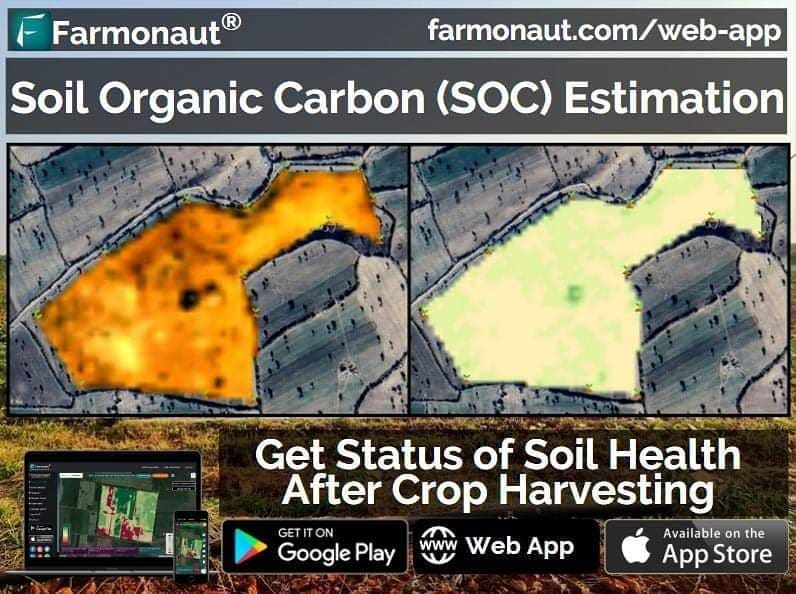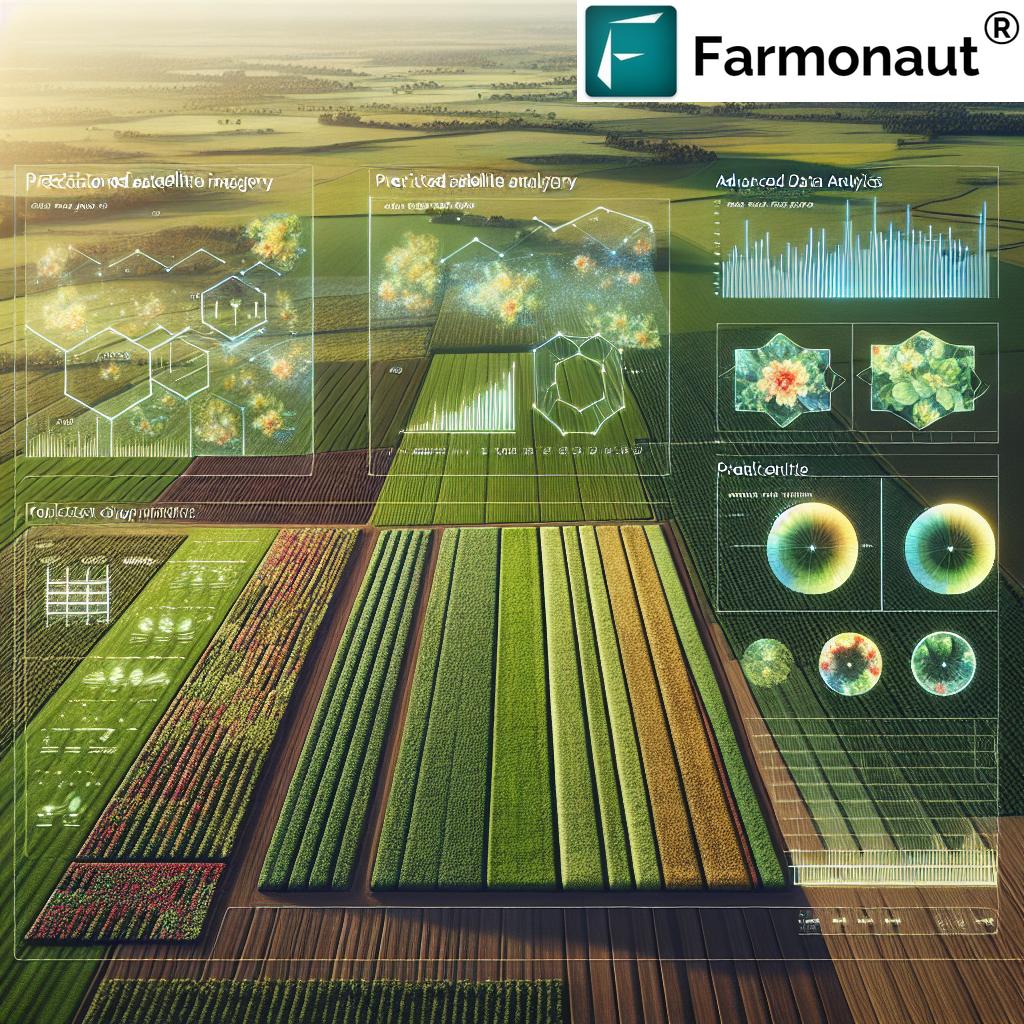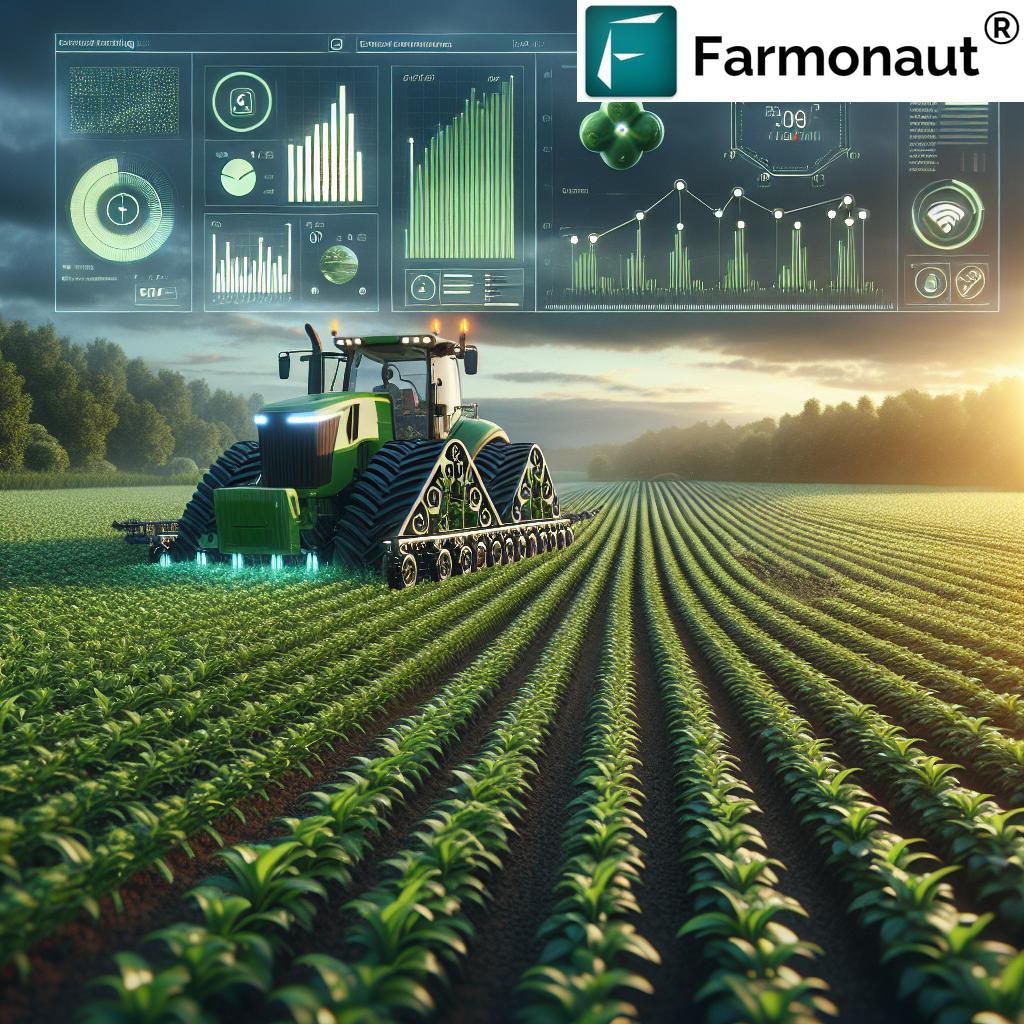Soil Organic Carbon: The Vital Component for Sustainable Agriculture

At Farmonaut, we understand the critical role that soil organic carbon (SOC) plays in maintaining healthy, productive agricultural systems. As pioneers in agricultural technology, we’re committed to helping farmers and agricultural professionals harness the power of SOC to improve crop yields, enhance soil health, and promote sustainable farming practices. In this comprehensive guide, we’ll explore the importance of soil organic carbon, its impact on agriculture, and how our cutting-edge satellite technology can help you monitor and manage SOC levels in your fields.
Understanding Soil Organic Carbon
Soil organic carbon is a crucial component of soil organic matter, which consists of plant and animal residues in various stages of decomposition. It plays a vital role in numerous soil functions and is essential for maintaining soil health and productivity. Let’s delve deeper into the significance of SOC and its impact on agricultural systems.
The Role of Carbon in Soil
Carbon is the backbone of soil organic matter and plays several critical roles in the soil ecosystem:
- Nutrient Retention and Turnover: SOC helps retain essential nutrients in the soil, making them available to plants over time.
- Soil Structure: It contributes to the formation of soil aggregates, improving soil structure and water infiltration.
- Moisture Retention: Organic matter increases the soil’s water-holding capacity, reducing drought stress on crops.
- Pollutant Degradation: SOC enhances the soil’s ability to break down and neutralize various pollutants.
- Carbon Sequestration: Soils with high organic carbon content act as carbon sinks, helping mitigate climate change.
- Soil Resilience: SOC improves the soil’s ability to withstand environmental stresses and recover from disturbances.
The Importance of Organic Content in Soil
The organic content of soil is a key indicator of soil health and fertility. Soils with higher organic content typically have:
- Better water retention capabilities
- Improved nutrient cycling
- Enhanced microbial activity
- Greater resistance to erosion
- Increased carbon sequestration potential
Understanding and managing the percentage of organic carbon in soil is crucial for sustainable agriculture. At Farmonaut, we provide tools to help farmers monitor and optimize their soil’s organic carbon content.
The Challenge: Post-Harvest Organic Matter Loss
One of the significant challenges in maintaining healthy SOC levels is the substantial loss of organic matter that occurs post-harvest. This loss can have a detrimental impact on soil health and subsequent crop yields. Here’s why:
- Removal of crop residues reduces the amount of organic matter returned to the soil
- Increased soil exposure leads to accelerated decomposition of existing organic matter
- Tillage practices can disrupt soil structure and expose protected organic matter to decomposition
- Changes in soil moisture and temperature can affect microbial activity and organic matter turnover
If SOC levels don’t recover before the start of the new crop cycle, farmers may experience uneven yields across their fields. This is where Farmonaut’s advanced satellite monitoring technology comes into play.
Farmonaut’s Solution: Precision SOC Monitoring
At Farmonaut, we’re excited to announce that our Soil Organic Carbon Content Estimation feature is now in beta stage, complementing our existing crop health and vegetation water stress satellite data services. Our cutting-edge technology allows farmers to:
- Identify areas with low SOC levels across their fields
- Target specific regions for soil testing and nutrient supplementation
- Monitor SOC recovery between crop cycles
- Make informed decisions about crop rotation and soil management practices
By leveraging our satellite-based monitoring system, farmers can take proactive steps to rejuvenate soil organic matter levels, ultimately leading to better yields and more sustainable farming practices.
How to Increase Soil Carbon
Increasing soil carbon is a crucial step towards improving soil health and productivity. Here are some effective strategies that we recommend:
- Minimize Tillage: Reduced or no-till practices help preserve soil structure and protect organic matter from rapid decomposition.
- Use Cover Crops: Planting cover crops between main crop cycles adds organic matter to the soil and prevents erosion.
- Implement Crop Rotation: Diversifying crops helps balance nutrient uptake and return different types of organic matter to the soil.
- Apply Organic Amendments: Adding compost, manure, or other organic materials can significantly boost soil carbon levels.
- Manage Crop Residues: Leaving crop residues on the field or incorporating them into the soil helps build organic matter.
- Use Precision Agriculture: Utilize Farmonaut’s satellite monitoring to target areas needing carbon improvement and optimize resource application.
- Plant Perennial Crops: Where possible, incorporate perennial crops or grasses into your rotation to build deep, carbon-rich root systems.
- Optimize Grazing Practices: For pastures, implement rotational grazing to promote plant regrowth and carbon sequestration.
By implementing these practices and monitoring your progress with Farmonaut’s satellite technology, you can significantly increase your soil’s carbon content over time.
Determination of Organic Carbon in Soil
Accurate measurement of soil organic carbon is essential for effective soil management. While laboratory analysis remains the gold standard for precise SOC determination, Farmonaut’s satellite-based estimation provides a cost-effective and rapid method for large-scale monitoring. Here’s an overview of common methods for determination of organic carbon in soil:
- Walkley-Black Method: A wet oxidation technique using potassium dichromate and sulfuric acid.
- Loss on Ignition (LOI): Measures weight loss after burning a soil sample at high temperatures.
- Dry Combustion: Uses specialized equipment to measure CO2 released from burning soil samples.
- Near-Infrared Spectroscopy (NIRS): Analyzes soil samples based on their reflectance of near-infrared light.
- Satellite-Based Estimation: Utilizes multispectral satellite imagery to estimate SOC levels across large areas.
Farmonaut’s satellite-based SOC estimation offers several advantages:
- Non-invasive monitoring of large areas
- Frequent updates without the need for repeated field sampling
- Cost-effective solution for regular SOC monitoring
- Ability to identify spatial variations in SOC across fields
While satellite estimation may not replace the need for occasional in-depth soil testing, it provides valuable insights for targeted soil management and helps farmers optimize their soil health strategies.
Farmonaut’s Comprehensive Farm Management Solutions
Our SOC monitoring is just one part of Farmonaut’s suite of advanced farm management tools. We offer a range of services designed to help farmers optimize their operations and improve productivity:
- Real-time crop health monitoring
- Vegetation water stress analysis
- Weather forecasting and alerts
- Pest and disease prediction
- Yield estimation
- Fertilizer and irrigation recommendations
By combining these tools with our SOC monitoring capabilities, farmers can make holistic, data-driven decisions that promote both productivity and sustainability.
Why Choose Farmonaut’s Satellite System?
Farmonaut’s satellite-based farm monitoring system offers several advantages over traditional drone and IoT-based solutions:
| Feature | Farmonaut Satellite System | Drone-based Monitoring | IoT-based Monitoring |
|---|---|---|---|
| Coverage Area | Large scale (1000s of hectares) | Limited (10s of hectares per flight) | Limited by sensor placement |
| Frequency of Updates | Daily to weekly | As per flight schedule | Continuous but localized |
| Initial Setup Cost | Low | High (drone purchase) | Medium to High (sensor network) |
| Operational Complexity | Low (automated) | High (requires piloting skills) | Medium (maintenance required) |
| Weather Dependency | Low | High | Medium |
| Data Processing | Automated and cloud-based | Often requires manual processing | Automated but may require calibration |
| Scalability | Highly scalable | Limited by equipment and personnel | Scalable but with increasing complexity |
Getting Started with Farmonaut
Ready to take your farm management to the next level? Here’s how you can get started with Farmonaut:
- Visit our web application or download our mobile app for Android or iOS.
- Sign up for an account and select your subscription plan.
- Add your fields by drawing polygons on the map or importing field boundaries.
- Start receiving regular updates on crop health, SOC levels, and other critical metrics.
- Use our AI-powered recommendations to optimize your farm management practices.
For developers and businesses looking to integrate our data into their own systems, we offer a comprehensive API. Check out our API documentation for more information.
Subscribe to Farmonaut
Ready to transform your farming practices with cutting-edge satellite technology? Subscribe to Farmonaut today and start optimizing your soil health and crop yields!
Frequently Asked Questions (FAQ)
Q: What is soil organic carbon (SOC)?
A: Soil organic carbon refers to the carbon component of organic matter in soil. It plays a crucial role in soil health, affecting nutrient retention, soil structure, water-holding capacity, and overall soil fertility.
Q: How does Farmonaut measure soil organic carbon?
A: Farmonaut uses advanced satellite imagery and spectral analysis to estimate soil organic carbon levels across large areas. While not as precise as laboratory testing, our method provides a cost-effective way to monitor SOC trends over time and identify areas that may need attention.
Q: How often should I monitor my soil’s organic carbon levels?
A: We recommend monitoring SOC levels at least seasonally, especially after harvest and before planting. However, with Farmonaut’s satellite monitoring, you can track changes more frequently without additional cost or effort.
Q: Can increasing soil organic carbon improve my crop yields?
A: Yes, higher levels of soil organic carbon are generally associated with improved soil health and fertility, which can lead to better crop yields. SOC contributes to better nutrient availability, water retention, and soil structure, all of which benefit crop growth.
Q: How long does it take to see improvements in soil organic carbon levels?
A: Increasing soil organic carbon is a gradual process. Depending on your management practices, you may start to see improvements within a year, but significant changes often take 3-5 years or more of consistent soil health practices.
Q: Is Farmonaut’s satellite monitoring accurate enough for precision agriculture?
A: Yes, our satellite monitoring provides sufficient accuracy for precision agriculture applications. While it may not replace the need for occasional soil testing, it offers valuable insights for targeted management decisions and helps identify areas that may need closer attention.
Q: How does Farmonaut’s SOC monitoring integrate with other farm management practices?
A: Our SOC monitoring is part of a comprehensive farm management system. It integrates seamlessly with our crop health monitoring, weather forecasting, and other tools to provide a holistic view of your farm’s health and productivity.
Q: Can Farmonaut’s system help me reduce my farm’s carbon footprint?
A: Absolutely! By helping you monitor and improve soil organic carbon levels, our system supports practices that sequester carbon in the soil. This not only improves soil health but also contributes to mitigating climate change.
Q: Is Farmonaut’s system suitable for small-scale farmers?
A: Yes, our system is designed to be accessible and beneficial for farmers of all scales. We offer different subscription tiers to accommodate various farm sizes and needs.
Q: How can I learn more about interpreting Farmonaut’s SOC data?
A: We provide comprehensive guides and support to help you understand and act on the data we provide. Additionally, our AI-powered advisory system offers personalized recommendations based on your farm’s specific data.
Conclusion
Soil organic carbon is a critical component of healthy, productive agricultural systems. By leveraging Farmonaut’s advanced satellite monitoring technology, farmers can gain valuable insights into their soil’s health and take proactive steps to improve SOC levels. This not only leads to better crop yields but also contributes to more sustainable and resilient farming practices.
We invite you to join the Farmonaut community and experience the power of precision agriculture. Together, we can cultivate healthier soils, more productive farms, and a more sustainable future for agriculture.
Start monitoring your fields now and embark on a journey towards optimized soil health and improved crop yields. Happy farming!













